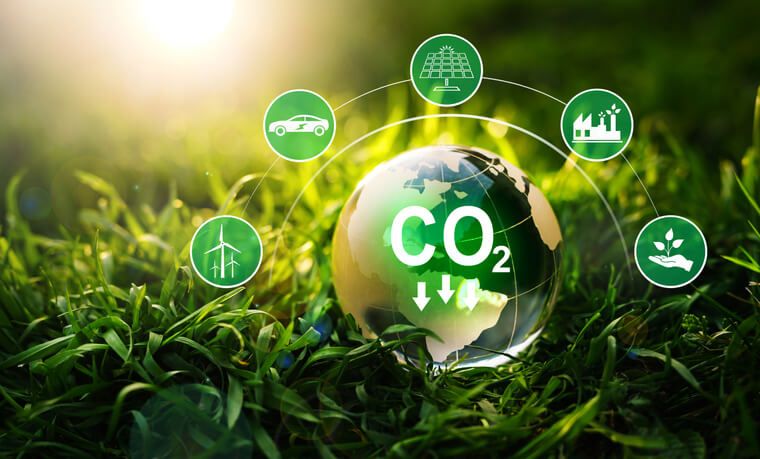4 Decarbonization Technologies Primed for Innovation

In 2019, a United Nations Environment Programme (UNEP) report stated that we must reduce global greenhouse gas (GHG) emissions by 7.6% per year between 2020 and 2030 to meet climate change targets. As carbon dioxide (CO2) comprises roughly ¾ of global GHG emissions, decarbonization is crucial to achieving this target.
So, which decarbonization technologies are primed for innovation and most likely to help us now?
Understanding Carbon Dioxide PPM and Symbiotic Solutions
To arrive at solutions, we need to understand the problem. CO2 currently comprises roughly 420 parts per million (ppm) of our atmosphere, according to the National Oceanic and Atmospheric Administration (NOAA). However, current carbon emissions output is widely distributed across sources.
In the US, the per-sector emissions generation breaks down as follows:
- Transportation – 27%
- Electricity – 25%
- Industry – 24%
- Commercial and residential – 13%
- Agriculture – 11%
Between emissions reduction and CO2 removal, expert estimates have identified a target of 350 ppm. With varied GHG generation causing the problem, the solutions we innovate will need to address the cause while operating symbiotically to overcome climate challenges.
1. Changing Our Fuel Sources
Alternative and renewable energies are necessary for slashing our CO2 output.
Data from the first five months of 2021 showed that we’re currently increasing CO2 ppm at a rate of 2.3 ppm per year. “Carbon neutral” emissions mean reducing this annual output to net zero. Alternative and renewable energies are crucial for meeting this goal.
Green Hydrogen and Renewable Energy Symbiosis
Carbon-based fossil fuels aren’t our only option to generate power. Hydrogen, compressed natural gas (CNG), liquified natural gas (LNG), and propane offer alternatives that rely on existing technology and benefit from ongoing innovation.
Per Deloitte, renewable energy installations (including green hydrogen) reached record highs last year despite COVID-19 and other global challenges. Crucially, hydrogen fuel can be used as an energy alternative for industries that may struggle to wean themselves from fossil fuels (e.g., metal manufacturing, transoceanic shipping, etc.).
Green hydrogen is produced by electrolysis, splitting water molecules into hydrogen and oxygen with electricity. While fossil fuels have traditionally provided this electricity, expanding our renewable power generation can further establish a sustainable process for creating hydrogen fuel.
However, only 4% of global hydrogen production is performed via electrolysis. The method is undoubtedly primed for innovation and will substantially benefit from the rise in renewable energy generated by solar, wind, and other means.
2. Storing and Transporting Alternative Energy
To ramp up renewable and alternative energy generation, we must store it effectively.
Per the World Economic Forum, four energy storage technologies are crucial to facilitating our global transition from fossil fuels:
- Pumped hydro: This method utilizes the same principle as the waterwheel, which we long relied on to generate power. During periods of surplus electricity, power is used to pump water uphill from one reservoir to another. When more electricity is needed, the water is released back down by moving through turbines which generate electricity as they rotate.
- Battery technologies: Lithium battery technologies have revolutionized power storage efficiency compared to their traditional lead-acid counterparts. While lithium batteries drive applications like electric vehicles (no pun intended), we’ve also begun building massive facilities for storage. The US’s largest lithium-ion battery storage facility can hold 300 megawatts (MW), half of the average coal plants’ output.
- Thermal Storage: Thermal storage allows us to drastically reduce the energy needed for heating and cooling by preserving hot or cold substances (e.g., water and sand) in insulated tanks and containers. The thermal storage market is estimated to triple in size by 2030.
- Mechanical storage: By scaling technologies we already use, we can readily increase our stored energy supply. For example, flywheels we already rely on to power lawnmowers and automotive engines can also harness rotational momentum to retain energy.
These technologies are all currently in use – they don’t only exist in imaginative sci-fi novels. Further innovations and scaling will enable us to continually optimize energy storage efficiency as we transition to alternative and renewable sources.
3. Carbon Capture
Aside from changing our energy sources and storage, we need to do something with all the CO2 in our atmosphere to begin reducing it towards that 350 ppm target. This will require its extraction, or “carbon capture.”
Three methods currently gaining greater traction are:
- Direct capture: This process involves pulling air in via large fans and passing it through a filtration system that separates the CO2. By further refining the CO2, we can even turn it into raw material and industrial input for resale. Integration with renewable energy sources and storage will allow these facilities to operate their energy-intensive processes without relying on fossil fuels.
- Carbon containment: While direct capture provides significant benefits, we can also integrate similar systems directly into manufacturing processes to prevent CO2 from entering the atmosphere to begin with. Expanding the prevalence of this process will require extensive filtration and duct systems like those in industry-standard HVAC systems.
- Biological solutions: Aside from manufacturing, we must recognize that plants have provided nature’s own carbon capture system throughout most of our existence on Earth. However, scientists across all disciplines are continually researching how to leverage and innovate “biosequestration.” They’re even looking beyond vegetation to solutions such as CO2-consuming bacteria.
To mitigate climate change, we don't only need to reduce our CO2 and other GHG emissions but continue innovating technologies that will undo some of the damage we've already caused.
4. Carbon Storage and Recycling
Much like innovations in energy storage, we need to continue developing the means to do something with the carbon we capture. The process of storing carbon is called “sequestration,” and exciting developments are progressing here as well.
With research long underway and many companies and scientists already innovating sequestration and recycling methods, we can turn to a surprising number of carbon containers, including:
- Concrete and other construction materials
- Hydrocarbon fuels
- Bioplastics and polymers
- Carbon nanotubes
We should consider fossil fuels one of Earth’s traditional carbon storage containers. When we use these fuels, their emissions release CO2 into the atmosphere. As a result, we’re gradually upsetting the overall balance, but innovations in carbon capture and sequestration (CCS) enable us to reset it.
Partner or Consult with FASTECH for Decarbonizing Technologies and Innovations
These technologies and innovations must ultimately work symbiotically to help us achieve global climate targets.
Alternative and renewable energies will drastically cut our emissions, and storage technology will increasingly make them economical and efficient. Similarly, CCS will enable us to reach a “carbon neutral”—and even “carbon negative”—goal despite the prevalence of tough-to-transition industries and processes.
At FASTECH, we leverage over 25 years of experience to help businesses pursue decarbonizing and other green initiatives through consulting, construction, maintenance, and testing services.
Contact us today to learn more about how our team of experts can support your renewable energy efforts.




